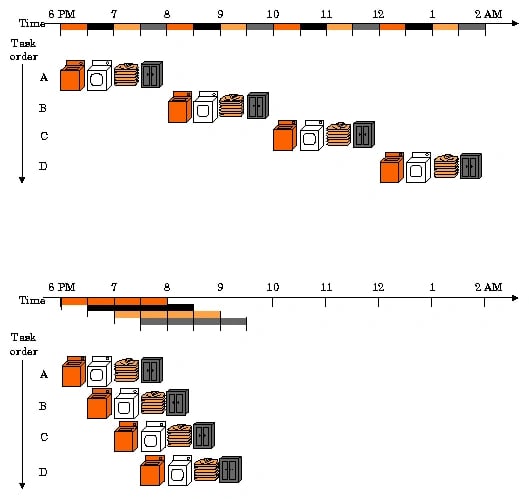订阅 wiki
Share wiki
Bookmark
Monad
Monad
Monad 是一个高性能的、与以太坊兼容的Layer 1 区块链。它显著增强了去中心化和可扩展性之间的平衡。Keone Hon(首席执行官)、James Hunsaker(首席技术官)和Eunice Giarta(首席运营官)是Monad的联合创始人。[1]
概述
Monad 是一个高性能、与 以太坊 兼容的 Layer 1 区块链,提供可移植性和高性能。它支持 以太坊虚拟机 (EVM) 的完全字节码兼容性,允许为 以太坊 构建的应用程序无需代码更改即可移植。Monad 还提供完全的 以太坊 RPC 兼容性,可与 MetaMask 和 Etherscan 等工具无缝使用。[2][3]
在性能方面,Monad 提供每秒 10,000 笔交易 (tps),相当于每天 10 亿笔交易,区块 时间为 1 秒,并具有最终性。这使其能够以较低的交易成本支持更多的用户和交互式体验。它实现的 以太坊虚拟机 符合上海 分叉,确保在模拟历史 以太坊 交易时获得相同的结果。[2][3]
Monad 的性能改进得益于多项创新:MonadBFT(具有额外研究改进的流水线式 HotStuff 共识)、延迟执行(共识 和执行之间的流水线以增加执行预算)、并行 执行和 MonadDb(高性能状态后端)。尽管具有 并行 执行和流水线,但 Monad 中的区块是线性的,交易在每个 区块 内线性排序。[2][3]
流水线
流水线是一种通过将任务分解为更小的单元以实现并行处理的方法。在计算机处理器中,流水线通过在单个时钟周期内并行执行一系列指令来提高吞吐量。 [4]

异步I/O
异步I/O是一种输入/输出处理方法,允许CPU在数据通信进行时继续执行其他任务。考虑到CPU与磁盘/网络操作之间存在显著的速度差异,异步I/O允许CPU启动I/O操作,并独立于I/O结果继续执行其他指令,而不是等待操作完成后再继续。 [5]
技术
MonadBFT
MonadBFT 是一种高性能的共识机制,旨在部分同步条件下实现交易排序,并能容忍拜占庭参与者。它源自 HotStuff,并结合了 Jolteon/DiemBFT/Fast-HotStuff 的改进。它是一种流水线式的两阶段拜占庭容错 (BFT)算法,具有乐观响应性。在正常情况下,它具有线性通信开销,在超时期间具有二次通信开销。MonadBFT 中的通信分阶段进行。领导者向投票者发送签名消息,然后投票者向后续领导者发送签名响应。MonadBFT 通过在领导者超时期间利用二次通信复杂度,将过程从三轮减少到两轮。[6]
延迟执行
Monad 区块链的一个新颖之处在于将执行与共识分离。共识涉及 Monad 节点 就交易的官方排序达成一致,而执行则执行这些交易并更新状态。 [7]
在 Monad 的共识中,节点 在领导者或验证节点 首先执行这些交易的情况下,就交易顺序达成一致。领导者提出一个排序,而不知道结果状态根,并且验证节点 在不验证所有交易是否在没有恢复的情况下执行的情况下,对区块的有效性进行投票。 [7]
这种方法使 Monad 能够实现显著的加速,使单分片区块链能够扩展到数百万用户。与 以太坊 不同,在 以太坊 中,执行是共识的先决条件,Monad 将这些过程分开。在 以太坊 中,节点 必须就交易列表和执行后的状态根达成一致,这要求领导者在共享提议的区块之前执行区块中的所有交易,并且验证节点 在投票之前执行这些交易。 以太坊 中的这种范例限制了执行时间,需要保守的 gas 限制,以确保计算在所有节点上都能在预算内完成,即使在最坏的情况下也是如此。 [7]
并行执行
Monad在保持以太坊执行语义的同时,并行执行交易。尽管存在这种并行性,Monad区块的结构与以太坊区块类似,交易按线性顺序排列。区块执行的结果在Monad和以太坊之间是一致的。 [8][9]
Monad促进EVM交易的并行执行,而无需共享依赖项。交易和区块保持线性排序,Monad识别此顺序中可并行化的交易。这提高了交易处理效率,而不会中断现有应用程序。为以太坊开发并部署在Monad上的应用程序将按预期运行。 [8][9]
没有共享依赖项的交易在单独的内核上并发执行,而具有依赖项的交易则按顺序执行。这种连续调度减少了I/O开销,这大大增加了当前EVM设置中的延迟。 [8][9]
MonadDb
MonadDb 是一种专门用于存储区块链状态的数据库。虽然大多数以太坊客户端使用 B-Tree 或 LSM-Tree 等键值数据库,但以太坊采用 Merkle Patricia Trie (MPT) 数据结构进行状态存储。这导致了一种次优的解决方案,其中一种数据结构嵌套在另一种不同类型的数据结构中。MonadDb 通过在磁盘和内存中原生实现 Patricia Trie 数据结构来解决这个问题。 [10]
Monad 以并行方式执行多个事务,因此需要非阻塞 I/O 操作才能进行数据库读取。MonadDb 利用异步 I/O (async I/O),利用最新的内核支持(例如 Linux 上的 io_uring)来高效地处理 I/O 操作,而无需依赖许多内核线程。除了异步 I/O 之外,MonadDb 还实现了与 I/O 相关的优化,绕过文件系统以减少开销。[10]
合作关系
投资者
2023 年 2 月 14 日,Monad Labs 宣布已筹集 1900 万美元的种子资金,由 Dragonfly Capital 领投。该轮融资有 70 名参与者,包括 Placeholder Capital、Lemniscap、Shima Capital 和 Finality Capital。天使投资人 Naval Ravikant(AngleList 的联合创始人)也参与了投资。 [16]
2024 年 4 月 9 日,Monad Labs 宣布融资 2.25 亿美元,Paradigm 领投。这一融资里程碑为扩大团队规模并将 Monad 投入生产提供了充足的资源。机构投资者包括 Electric Capital、Castle Island Ventures、Greenoaks、eGirl Capital、Rebirth Ventures、Amber Group、Animoca Ventures、Archetype、Bankless Ventures、Big Brain Holdings、Bodhi Ventures、Breed、Caladan、CMS Holdings、Coinbase Ventures、CoinFund、DBA、Edessa Capital、Figment Capital、Flow Traders、Galaxy、GSR Ventures、Hailstone Labs、Hermeneutic Investments、HTX Ventures、IOSG Ventures、Lightspeed Faction、Makers Fund、Manifold Trading、Merit Circle、Mirana Ventures、Nascent、Presto Labs、Robot Ventures、SevenX Ventures、Shoe on Ventures、Superscrypt、Tess Ventures、Wintermute Ventures 等。天使投资人包括 Inversebrah、Ansem、Hsaka、punk6529、Saquon Barkley、Eric Wall、Rune Christensen、Bryan Pellegrino、Robinson Burkey、Luca Netz、Mert Mumtaz、Shoku 等。 [11]
集成
MON 空投
2025年10月14日,Monad 基金会 宣布进行 MON 空投,以便在 Monad 公共主网 启动之前,将其原生代币 MON 分发给主要贡献者和社区成员。空投 将代币分配给 Monad 社区的 5,500 名成员以及更广泛的加密社区的近 225,000 名成员,包括来自 以太坊 和 Solana 生态系统的参与者。
资格扩展到各个群体,包括活跃的 Monad 社区成员、重要的 DeFi 用户以及著名 NFT 系列(如 Pudgy Penguins 和 Mad Lads)的所有者。用户可以在官方申领门户网站 claim.monad.xyz 上查看他们的资格。 [17]
发现错误了吗?
